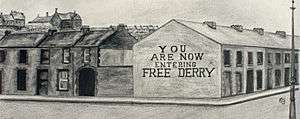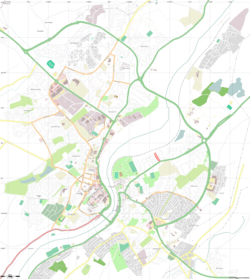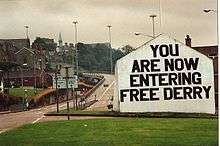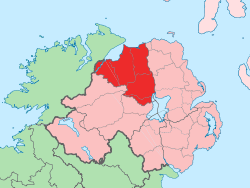Free Derry Corner
Free Derry Corner is a historical landmark in the Bogside neighbourhood of Derry, Northern Ireland, which lies in the intersection of the Lecky Road, Rossville Street and Fahan Street. A free-standing gable wall commemorates Free Derry, a self-declared autonomous nationalist area of Derry that existed between 1969 and 1972. On the corner is a memorial to the 1981 hunger strikers and several murals. There is also a memorial to those who died engaging in paramilitary activity as part of the Provisional IRA's Derry Brigade.
 Artist's rendition of the corner as it appeared in 1969. The terraced houses were demolished shortly afterwards, but the wall with the slogan was retained. | |
 Location in Derry  Free Derry Corner (Northern Ireland) | |
| Coordinates | 54.99564°N 7.326856°W |
|---|---|
In January 1969 a local activist, long believed to be John "Caker" Casey, but who might have been Liam Hillen, painted graffiti on a gable wall at the end of a housing terrace stating "You are now entering Free Derry".[1][2] When the British Home Secretary, Jim Callaghan, visited Derry in August 1969, the "Free Derry" wall was painted white and the "You are now entering Free Derry" sign was professionally re-painted in black lettering. The area in front of the wall became known as Free Derry Corner by the inhabitants. It and the surrounding streets were the scene of the Battle of the Bogside in 1969 and Bloody Sunday in 1972. The houses on Lecky Road and Fahan Street were subsequently demolished, but the wall was retained. It has been repainted at frequent intervals. As currently situated, it now lies in the central reservation of Lecky Road, which was upgraded to a dual carriageway sometime following the demolition of the original terraced houses.
 Free Derry Corner in 1984.
Free Derry Corner in 1984.- View of the corner from the Hunger Strike memorial, showing the "petrol bomber" mural.
 The Hunger Strike memorial, which faces the Free Derry wall.
The Hunger Strike memorial, which faces the Free Derry wall. The Free Derry wall in 2018.
The Free Derry wall in 2018.
References
- Kerr, Adrian (16 November 2009). "A silent and powerful witness to troubled times". Derry Journal. Retrieved 15 September 2017.
- Sweeney, Eamon. "'You Are Now Entering Free Derry': Man who painted iconic slogan passes away". Derry Now. Retrieved 1 January 2019.
External links
| Wikimedia Commons has media related to Free Derry Corner. |
- Photograph of the original slogan at Museum Of Free Derry.
- A visual history of Free Derry Corner.
- A BBC gallery of 12 images of Free Derry Corner.

